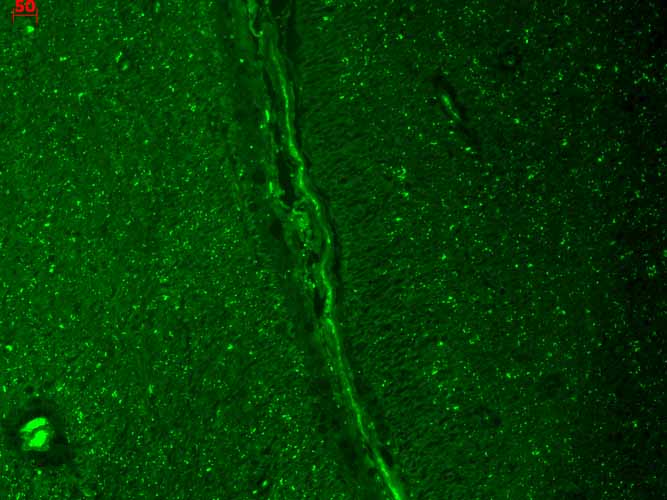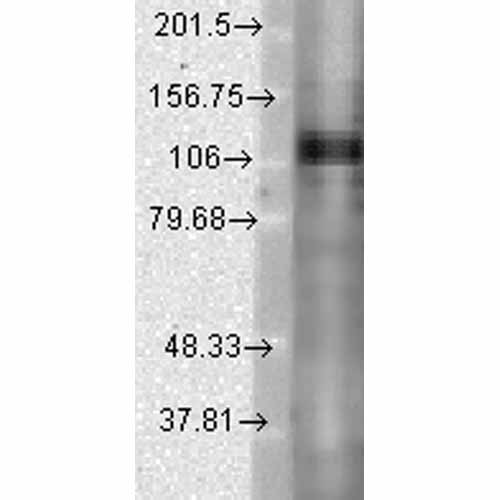Kv3.1 Antibody
Kv3.1 Antibody, Clone S16B-8
- SPECIFICATION
- CITATIONS
- PROTOCOLS
- BACKGROUND

Application
| WB, IHC, ICC, AM |
|---|---|
| Primary Accession | P25122 |
| Other Accession | NP_036988 |
| Host | Mouse |
| Isotype | IgG1 |
| Reactivity | Human, Mouse, Rat |
| Clonality | Monoclonal |
| Description | Mouse Anti-Rat Kv3.1 Monoclonal IgG1 |
| Target/Specificity | Detects ~110kDa. Weakly reactive in human samples. |
| Other Names | Krc2 1 Antibody, NGK2 Antibody, KCNC1 Antibody, voltage gated potassium channel subunit Kv3.1 Antibody, Kv4 Antibody |
| Clone Names | S16B-8 |
| Immunogen | Fusion protein amino acids 437-585 (C-terminus) or rat Kv3.1b |
| Purification | Protein G Purified |
| Storage | -20ºC |
| Storage Buffer | PBS pH7.4, 50% glycerol, 0.09% sodium azide |
| Shipping Temperature | Blue Ice or 4ºC |
| Certificate of Analysis | 1 µg/ml of SMC-313 was sufficient for detection of Kv3.1b in 10 µg of rat brain lysate by colorimetric immunoblot analysis using Goat anti-mouse IgG:HRP as the secondary antibody. |
| Cellular Localization | Membrane |

Thousands of laboratories across the world have published research that depended on the performance of antibodies from Abcepta to advance their research. Check out links to articles that cite our products in major peer-reviewed journals, organized by research category.
info@abcepta.com, and receive a free "I Love Antibodies" mug.
Provided below are standard protocols that you may find useful for product applications.
Background
Potassium voltage-gated channel, Shaw-related subfamily, member 1, also known as KCNC1 or Kv3.1, is a human gene. The Shaker gene family of Drosophila encodes components of voltage-gated potassium channels and is comprised of four subfamilies. Based on sequence similarity, this gene is similar to one of these subfamilies, namely the Shaw subfamily (1). The protein encoded by this gene belongs to the delayed rectifier class of channel proteins and is an integral membrane protein that mediates the voltage-dependent potassium ion permeability of excitable membranes. Kv3.1b has been extensively tested in the auditory regions of mammals, and the decline of Kv3.1b expression appears to correlate with the functional decline in the medial olivocochlear efferent system (2). Other research shows potential for Kv3.1b channels to be oxygen sensors (3).
References
1. Xu M., et al. (2007) J. Neuroscience. 27(51): 14158-14170.
2. Zettel M.L., Zhu X., O’Neill W.E., Frisina R.D. (2007) J Assoc Res Otolaryngol. 8(2): 280-293.
3. Osipenko O.N., Tate R.J. and Gurney A.M. (2000) Circ Res. 86(5): 534-540.
If you have used an Abcepta product and would like to share how it has performed, please click on the "Submit Review" button and provide the requested information. Our staff will examine and post your review and contact you if needed.
If you have any additional inquiries please email technical services at tech@abcepta.com.













 Foundational characteristics of cancer include proliferation, angiogenesis, migration, evasion of apoptosis, and cellular immortality. Find key markers for these cellular processes and antibodies to detect them.
Foundational characteristics of cancer include proliferation, angiogenesis, migration, evasion of apoptosis, and cellular immortality. Find key markers for these cellular processes and antibodies to detect them. The SUMOplot™ Analysis Program predicts and scores sumoylation sites in your protein. SUMOylation is a post-translational modification involved in various cellular processes, such as nuclear-cytosolic transport, transcriptional regulation, apoptosis, protein stability, response to stress, and progression through the cell cycle.
The SUMOplot™ Analysis Program predicts and scores sumoylation sites in your protein. SUMOylation is a post-translational modification involved in various cellular processes, such as nuclear-cytosolic transport, transcriptional regulation, apoptosis, protein stability, response to stress, and progression through the cell cycle. The Autophagy Receptor Motif Plotter predicts and scores autophagy receptor binding sites in your protein. Identifying proteins connected to this pathway is critical to understanding the role of autophagy in physiological as well as pathological processes such as development, differentiation, neurodegenerative diseases, stress, infection, and cancer.
The Autophagy Receptor Motif Plotter predicts and scores autophagy receptor binding sites in your protein. Identifying proteins connected to this pathway is critical to understanding the role of autophagy in physiological as well as pathological processes such as development, differentiation, neurodegenerative diseases, stress, infection, and cancer.



